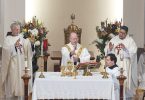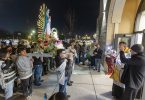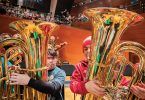by Jill Ragar Esfeld
jill.esfeld@theleaven.org
SHAWNEE — “I’m probably the only podiatrist in the world who paints icons,” said Olathe Prince of Peace parishioner Raphael Nguyen during an iconography workshop sponsored by Good Shepherd Parish here.
Nguyen admitted that when he signed up for the intensive four-day program, he was a little intimidated. And his wife didn’t help.
“I saw it in the bulletin and my wife said, ‘You have no artistic ability. What are you going to do with this?’” he recalled.
“And I said, ‘You know what? I don’t care. It’s the theology and the spirituality behind it that draws me.’”
Nguyen, who recently completed his master’s in theology, never dreamed he would create something beautiful enough to display in his office, but he did.
Workshop leader Cecelia Aguallo was not surprised.
From experience, Aguallo has learned that iconography is as much a spiritual journey as it is a creative process. Though the student does the work, God leads the way.
And God’s way is always beautiful.
Spreading the Word
Good Shepherd parishioner lisa Cummings organized the workshop. Although she does have a degree in art, Cummings also has eight children.
For many years, her artistic talents were employed entertaining them. Then one day she saw a display of icons done by a nun in Atchison.
“It was like a hammer over the head,” she said. “I thought, ‘This is what I’m supposed to do!’”
Cummings started searching the Internet for information on iconography and found the Prosopon School. She attended one of its workshops in denver, where she met Aguallo.
“After I’d been to three of their workshops, I just wanted to bring it to Kansas City,” she said. “I started e-mailing Cecelia, and she said she would be willing to come here and do a workshop.”
Aguallo, a longtime student and instructor in the Prosopon method, has produced many icons and is in an iconographers’ guild at St. dominic Parish in denver.
Her own fascination with iconography started when her mother died 17 years ago and she found a small icon among her belongings.
Inspired by its beauty, Aguallo kept the icon as a memento.
“And it just kept calling to me,” she said.
She answered the call in 2002, when she attended her first Prosopon workshop.
“When I went in, it was like I finally knew what I was meant to be when I grew up,” she said. “It’s like I’d been a sojourner until then.”
Not only had she found an outlet for her creativity, she’d also discovered a method for increasing her faith and deepening her relationship with God.
Because Aguallo believed that other Catholics would be as “on fire for this” as she was, she was determined to share what she’d discovered.
She started off by assisting in workshops, but eventually she designed one she could lead on her own.
“I’ve been blessed,” she said. “God’s been very good to me to allow me to help other people find out how to do this and understand that everything you do has a meaning.
“Everything.”
Paint and prayer
The process of creating an icon is complex and deeply symbolic — from the angle of the board’s grain, which must move up toward heaven, to the application of each layer of the image. The work is done in a contemplative atmosphere. The iconographer uses gold leaf and egg-tempera paints that are hand-mixed using natural pigments similar to those used by ancient masters of the art.
The image is built through layers of color, highlights and transparent washes called “floats.”
Every color, texture and brush stroke has meaning, and each step is accomplished with deep reflection and prayer.
Ascension parishioner Kathie Hahn has a background in nursing, but decided to take the workshop because of her love for Renaissance art.
She admitted that when she began the workshop, she was praying to St. Jude — the patron saint of impossible causes. But she’s been surprised by the creative and spiritual journey that has drawn her so close to fellow students.
“So much goes into making this icon,” she said. “There are a lot of layers, there’s a lot of depth, there’s a lot of prayer. We’ve had fun laughing and praying and fretting together.”
Students begin each day with a traditional iconographer’s prayer and continue to pray throughout the day.
“I encourage them to remember the Jesus prayer: ‘Lord Jesus Christ, Son of God, have mercy on me, a poor sinner,’” said Aguallo.
Another prayer, she said, involves you praying Jesus’ name as you inhale, and “I belong to you” as you exhale.
“I am praying constantly while I’m doing it,” explained Hahn as she painted. “That He guides my hand and makes me worthy to do this.”
To give her students confidence in their ability to conquer the complex art of iconography, Aguallo admits to them that her prayer in her first workshop was simply, “Help me, God. Please.”
The key, she said, is relying on God to guide the work.
“Like Saint Francis said, ‘let us be an instrument of your peace’ — that’s what we are, instruments,” she explained. “Anything good on my board definitely comes from Christ. There’s nothing I can do of myself.”
It’s that attitude that helped Nguyen accomplish the task.
“We follow good instructions and we give up everything,” he said. “We are just instruments. It’s not about perfection.
“It’s about the image and who’s behind it.”
Living icons
Aguallo said her mission is to help students understand that icons are part of our Catholic heritage and we belong to them as much as they belong to us.
“We’re all living icons,” she explained. “We’re all in the process of formation.”
To bring home that point, Aguallo chose an image of John the Baptist for her students to start with.
“John’s journey as a witness for Christ is mirrored by the iconographer,” she said. “With every step we take, we are witnessing.”
Curé of Ars, leawood, parishioner Alice Carman is a professional artist, specializing in water color. She just finished a master’s in art history and signed up for the workshop because she has an interest in Byzantine art.
“Cecelia is a wonderful instructor,” she said. “Being an artist, I’m very interested in the process and, of course, you don’t read about the spiritual aspects of the process when you study art history.”
Good Shepherd parishioner Christine Abraham was inspired to take the workshop when she saw an icon Cummings had made as a gift for her father-in-law.
“I just thought it was absolutely gorgeous,” she said. “I looked at it as a piece of art, but when you tie in the spiritual, it’s a thing of beauty.”
The process of making an icon is so personal that Aguallo said when she parts with one, it’s like giving away one of her children. But she loves knowing that her icons will continue to witness long after she is gone.
“Thank you, God. That’s a legacy I’m looking forward to,” she said. “Sometimes I feel such humility because God uses a sinner like me to do something like this.”
Giving is part of the process. As a reminder of that, Aguallo said, the last line the iconographer adds to the board is always pure white.
“For the purity of God,” she explained. “And also a reminder that there’s another empty board waiting for the iconographer to paint.”






